The following is an excerpt from Joe McNally’s book, The Real Deal.

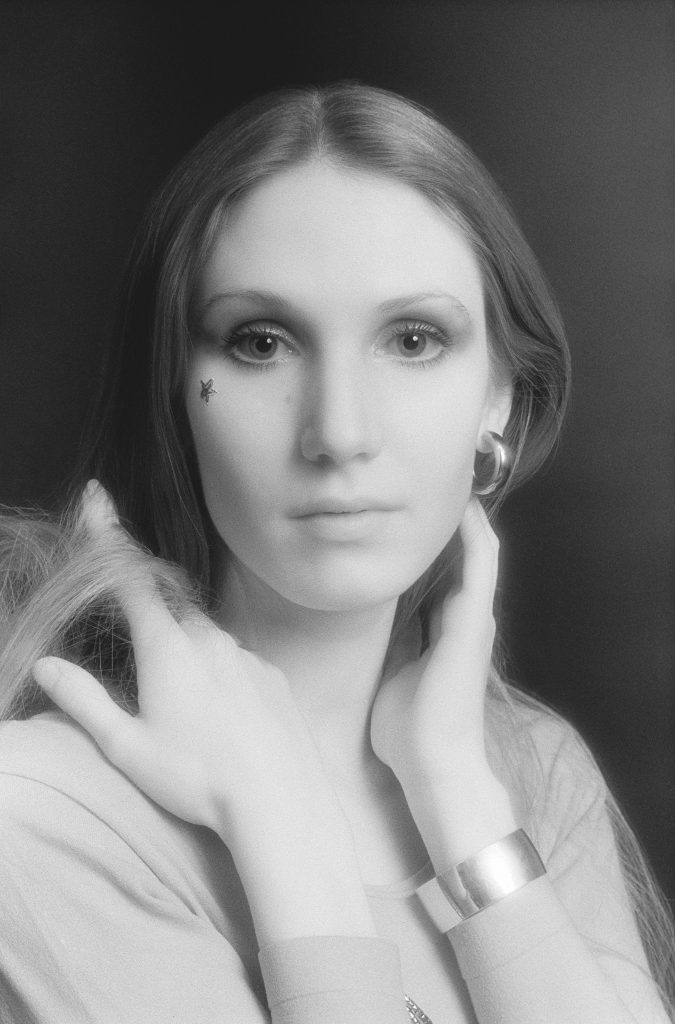
I started experimenting with flash back in college. We had, as I remember, anvil-like Ascor powerpacks that were blocky and weighty, and not particularly hot swappable—as in, if you weren’t careful on the electrical front, the pack could easily arc, and blow you and/or your model across the room. Tough to reestablish confidence in your subject when you just melted the power box and you look like a cartoon character who just peed on an electric fence. But the idea of controlling light and the look of it was drumming in my head. I was training to be a newspaper photog, run and gun, but at the same time I was poring over the work of Avedon, Penn, Helmut Newton, and Guy Bourdin. The image shown here (left) was perhaps the one lonesome success I produced in the Newhouse School photo studio.
The subject is my good bud (still in touch on Facebook) Nancy Barnes. She was a drama student and lovely in front of the camera. Not content to just mess unknowingly with lights, I shot this on B&W infrared film, essentially copying the work of another friend and fellow student, Dennis McDonald. He went on to be an incredibly fine newspaper photographer in his native South Jersey. He was messing with infrared, and I loved the look. (Dennis also shot the final pic in this book, way up on the Verrazzano Bridge.)
Nancy sat for me patiently, and beautifully, as I worked out this unknown terrain. The extent of our “styling” was the sticky silver star affixed to her cheek. Styling on a student budget!
I continued to play with cumbersome flashes when I hit the Daily News. Eddie Peters, a stellar, long-time staffer who had gone inside as a boss, gave me his old case of potato mashers, powered by wet cell battery packs. Crude, no controls, and heavy. With one of them, an umbrella, and a guess of an f-stop, I made a picture of Prince Paul, the Ringling Brothers Circus clown (below).
John Loengard, the DOP at LIFE, and a mentor, liked the picture. To him, it was “peculiar.” He also said it was a bit of a window into the interior of a performer’s life, as the powdering and makeup process looked, in his words, “painful.” Some of the oddity here comes from the formidable flash, freezing all the powder in the air around the Prince. At that point, I had no real understanding of why, but I was fevered with flash, and the possibilities.
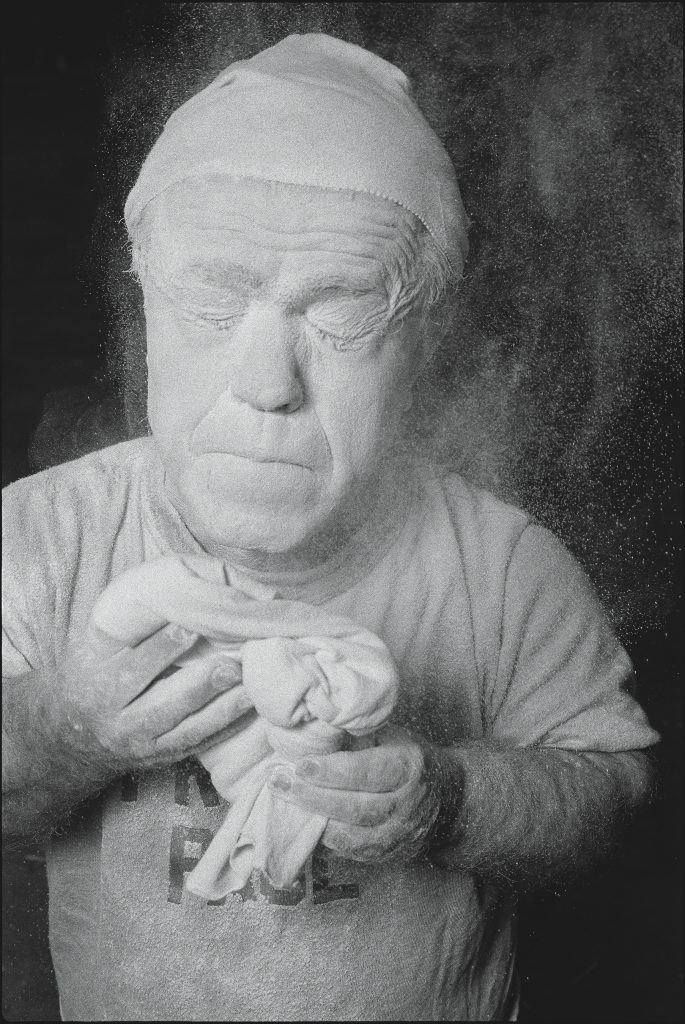
One can imagine what a gift a Speedlight seemed to be! Having toted bulky, undependable lights for years, I was looking at something light, controllable, and smart. Well, okay, back then, not exactly “smart.” It was like when you go into the parent-teacher meeting, and teach says your sixth grader has “great potential.”
I was able to put away the long division of guide numbers and camera-to-subject distance! Not that I used the formulas very much. I made gut calls, thumb in the air, nose to the sky. Now, I had a partner in making those calls! This will be easy!
And comparatively, it was. However, easy is not to be confused with dependable. TTL (through the lens) flash photography has been much decried over the years as being error-prone and unknowable, a dark, magic brew possessed of fearfully uncertain powers. Shakespeare, when he penned Macbeth, might well have been describing TTL flash, an alchemy that’s akin to a witch’s spell, mixing parts of snakes, bats, lizards, and the like. “For a charm of powerful trouble, / Like a hell-broth boil and bubble.”
And then, with a cackle and a pre-flash, see if the exposure corresponds to your chosen f-stop. And don’t forget to wear a pointy hat.
The thing is, back then, it didn’t correspond all that often. About as precise as a thrown hand grenade, these flashes were the roulette wheel of exposure. They performed, or not, in whimsically vexing fashion.
In one instance, it would give you perfection.
And then, in the next, blowout. All within minutes, or seconds, as you shot your way through a job. I like the term “blowout.” It’s perfect to describe TTL losing it. You’re cruising down the highway, going like sixty, as they say, and then . . . blowout! The wheel wrenches in your hands, and you scrape sideways across the highway. Out of control. In the ditch.
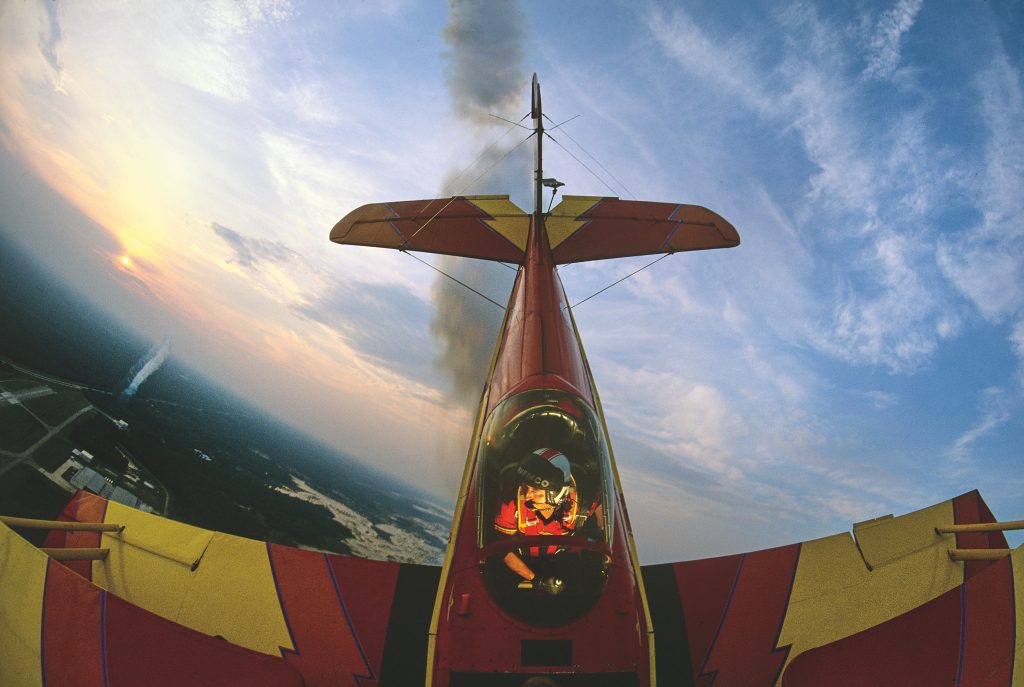
Encroaching darkness, backgrounds, closeness of your subject, color of their garments—all could create an exposure fracas. For instance, while this biplane was zooming along and there was light in the sky, i.e., information for the camera/flash tandem to chew on, you’d be okay. But let darkness take its course, and the flash would respond. Blowout!
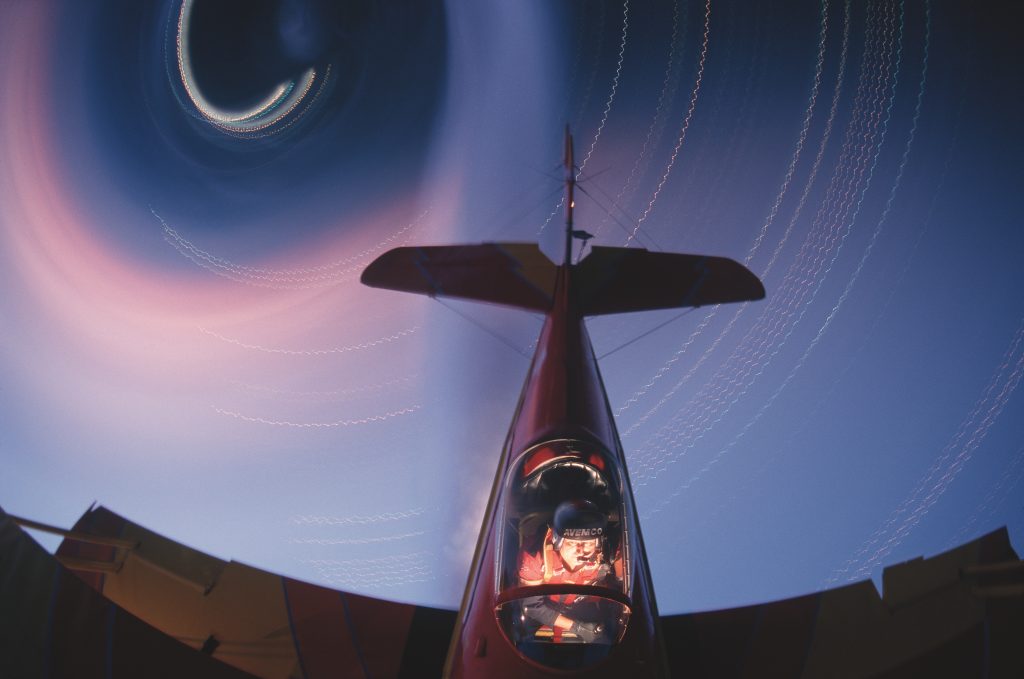
I kept at it. Having no other choice is a great motivator. The path my imagination was leading me, even back then, was toward a world that I would need to parse out with the application of light. I was shooting for magazines that demanded high gloss and big color. Film was unforgiving and had serious limits in the realm of pushability. ISO 50,000 was not even a shimmering mirage, far ahead in the desert. The fault line for getting an assignment often swung on whether the photog could use a flash well. I wanted to work.
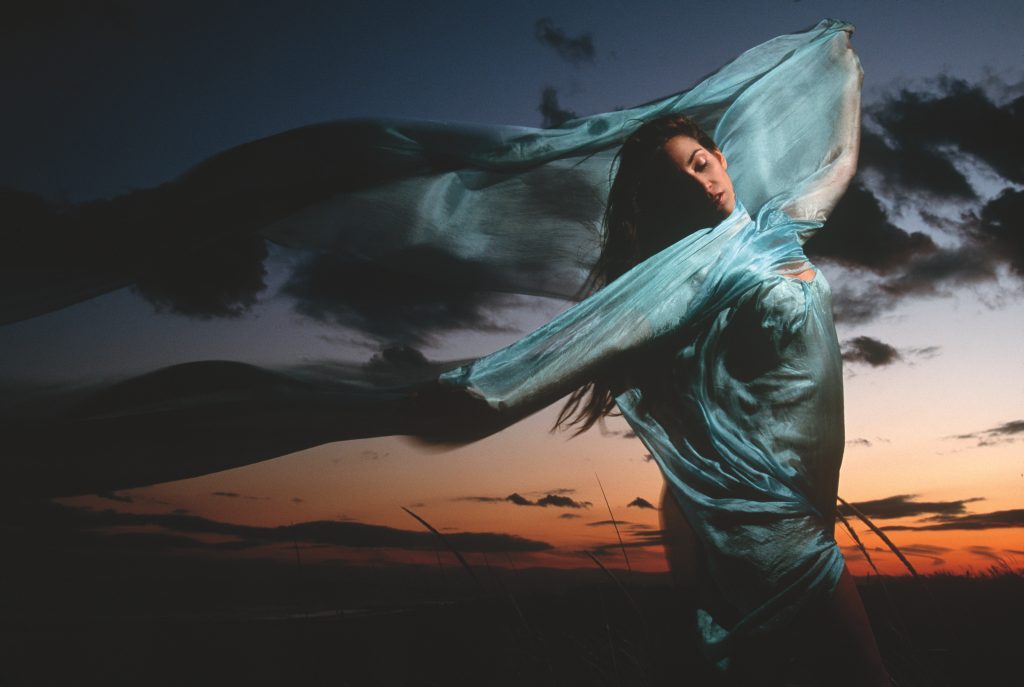
I plunged into the uncharted swamp of TTL flash. I had many failures, but failures are great teachers. I learned the value of risk, as well as the rewards that trusting the tech and pushing the system can bring. I have always said that flash photography is a lifelong series of experiments, which I continue to engage in, and those adventures alternately lift my heart or crush my spirit.
My level of determination was an exasperation to those around me. Everyone was a target for a TTL portrait session! My oldest daughter, Caitlin, went for a while to an Isadora Duncan dance class, she of the veils and the dreamlike moves. Not one to let an opportunity pass, I took her instructor out to the Brooklyn beaches (above). Just me, my subject, one stand, and one flash. Hard flash. No assistant,so no putting up an umbrella on the windswept shores of the Rockaways. It was probably my first inkling that these little Speedlights—fragile as they were, teetering on the edge of uncertainty—held great promise for effective lighting solutions, done with minimal gear and maximum mobility.
It’s the way of this life as a photographer. Nothing is certain, really, when you venture with a camera, and then especially when you add the mystical component of flash. When you let the camera decide certain things for you, some describe it as irresponsible, and they raise questions about your judgement at the lens. “Why don’t you use manual?” is a question I hear often. I do use manual, in relentless fashion.
I use TTL as well, and view it as a helpful pathfinder in certain scenarios. It’s the blazing headpiece atop the Staff of Ra, helping Indy find the Ark. The path TTL nimbly leads you down can easily result in a manual solution that you then dial in with certainty, like the sturdy dock where you tie off the bobbing boat. Or, nowadays, given the dependability of this technology, you can let it ride in through-the-lens mode, and just closely monitor the camera as it makes its decisions. You can feel it at the camera when all is working; your head is close-in to the machinery, and with the flashes nearby, there’s an intuitive connection between you, the camera, and the flash system. You can also tell if it’s confused, as you listen to the shutter drag, for instance, if you are in Aperture Priority. Or you hear (and feel) as the TTL misreads and dumps full power on your subject, turning them into a glowing fuel rod right there on your LCD. A full-power thunk from the Speedlight! Blowout!

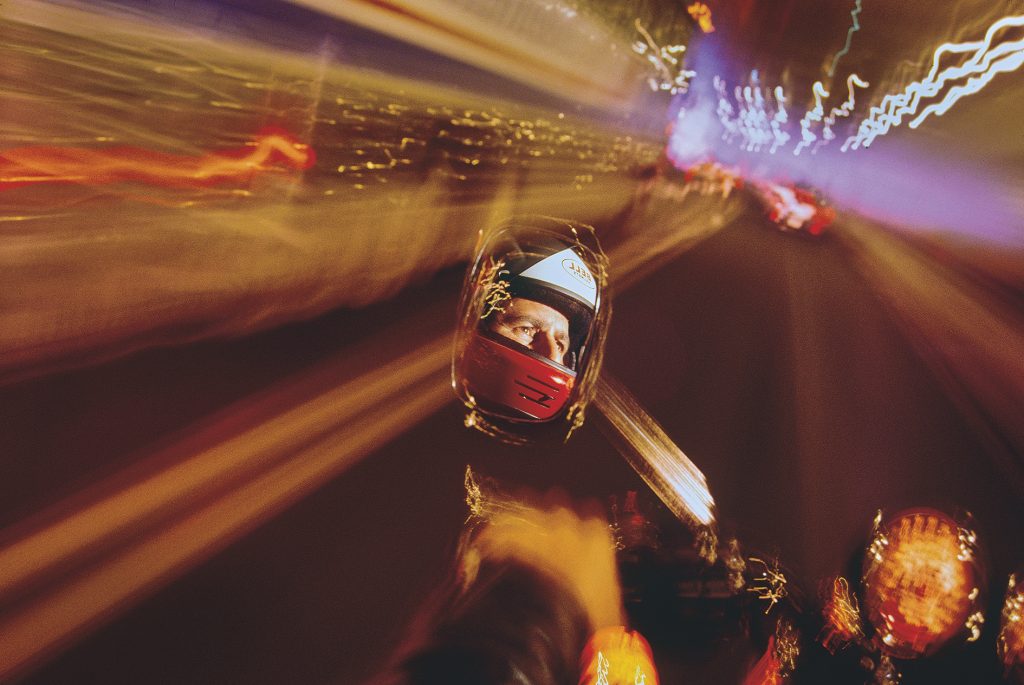
You can also pick up the relative power of your exposure, which is why I always have instant replay turned on. With your eye jammed into the eyepiece, there’s a certainty you can feel when the picture just made dupes into the LCD. Right? Too bright? Too dark? You can read it, feel it, right there in the lower quadrant of your eye. Now, with EVF and mirrorless becoming the standard, all the info is automatically right there in your electronic viewfinder as you shoot.
So, take a plunge. As they say, what could go wrong? It’s just a bunch of pixels! If you are in the mood for experimentation, grab one flash. Don’t confuse the issue. Just one. Read the manual! What a novel idea!
Then take it and mess around. And I mean, mess around!
I don’t recommend this, ’cause it’s nuts, but I put one on the handles of a motorcycle, wrapped two SC-17 cords around the biker to the camera’s hot shoe, and then half stood in the back seat of the bike as it whizzed through the Lincoln Tunnel in NYC (above). Pulled a focus on the driver’s eyes and worked the TTL prayer beads. Nowadays, in this world of radio TTL, SC-17 cords are unnecessary. And, given current technology, if exposures are looking slightly wonky, you can change the flash power while the bike is zooming along. Great evolutions in the world of TTL hotshoe flash. Not possible for me, tipping around on this bike.
The tunnel’s interior gave the flash some measure of constant light level, which was a great thing to offer these TTL small flashes, still in their infancy. I did runs on TTL, and runs on manual, as that made good sense, because the biker stayed at the same distance relative to the flash. If he had made any radical changes in distance, we would’ve both had much more to worry about than flash exposure.
By contrast, what would bedevil early TTL was in-and-out changing light levels, such as in . . . Times Square! When Sam, who was a phenomenal athlete, and at the time making a living as a bike messenger, rolled through that maelstrom of blinking and flickering display neon, I had a lot of failure, and was lucky to get a decent shot (below).
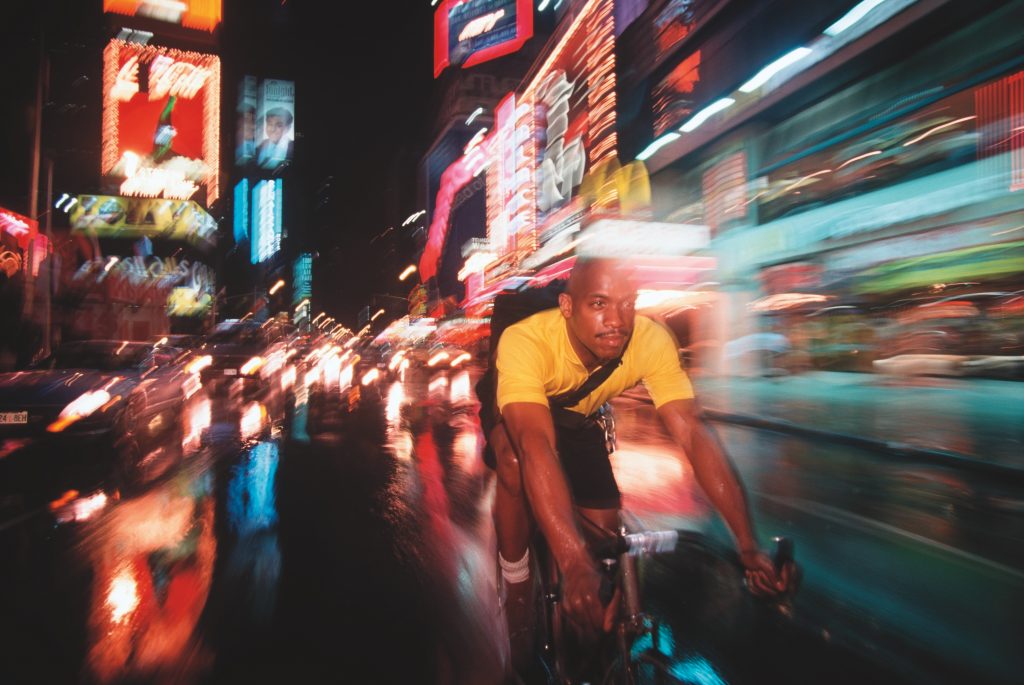
I shot Sam out of the back of a minivan, hatch door up. This was shot in the mid-’90s or so.
Fast forward to much, much better TTL, and in 2010 I am, again, hanging out of the back of a van, this time in Vancouver (below). Some things don’t change.
Here, the concert performance of the camera is truly approaching symphony-like levels. I’m using AF and Aperture Priority mode at camera. I’ve rigged the minivan with an upper main light and a light off camera, to the right, for fill and some directionality. I’m speaking to the flashes via line-of-sight commands at the camera, which is a lock, of course, as the flashes are right next to me. The piece of this puzzle that constantly varies is not the exposure; we were shooting in the Pacific Northwest, with its seemingly infinite cloud canopy.
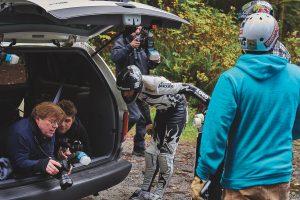
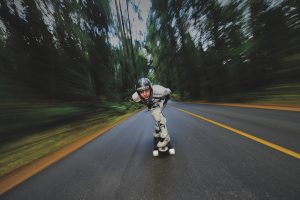
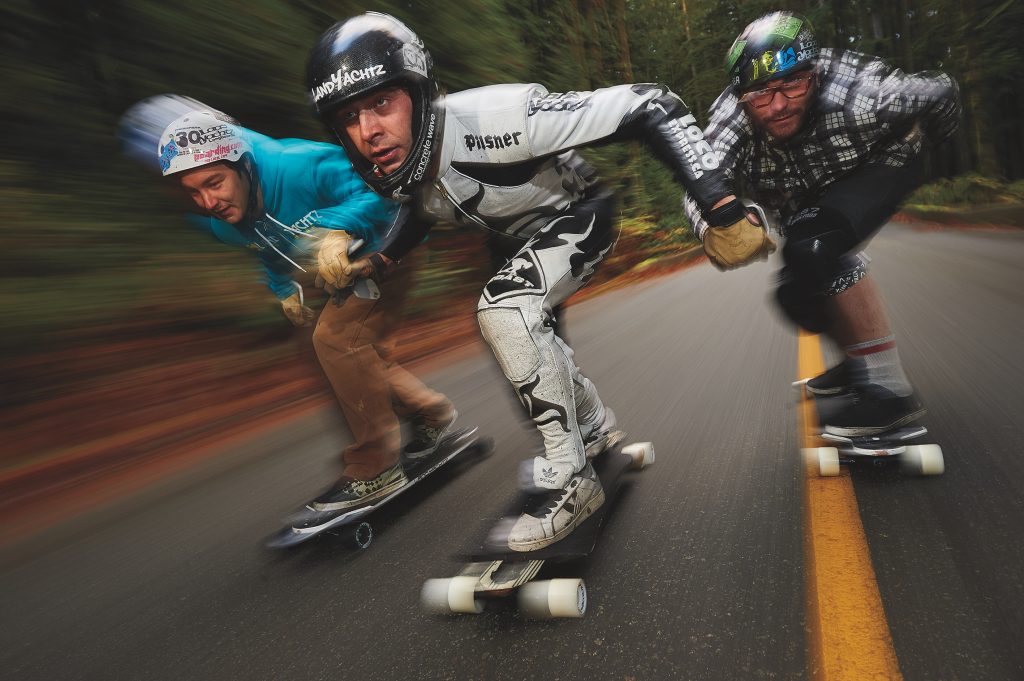
The big variant was the distance the skateboarders maintained with the vehicle.
We’d have one situation, where they were right on the bumper.
And then another, when a drift would occur.
The flash kept pace and made exposure adjustments, dealing with the deep surrounding greenery and not blowing out the banging-white skating leathers of the lead longboarder. Moving fast like this, with everything fluid, reliance on the machine allows you, at camera, to concentrate on what’s important, such as framing, and holding your camera as steady as possible. The frame of the single skateboarder is 1/6th of a second, handheld. That’s enough to worry about, right there.
You could get a bunch of mirrors, and just one Speedlight (below). Years ago, out on a Florida beach, there were a bunch of retirees conducting their late day walk. They stopped and tilted their heads while we frantically dug these mirrors into the sand, racing the falling light. I swear I heard one of them say, in a beautiful southern drawl, something to the effect of, “Look at that fella over there with all those mirrors. He surely does like himself!”
One raw flash, camera left. The mirrors were by far the hard part.
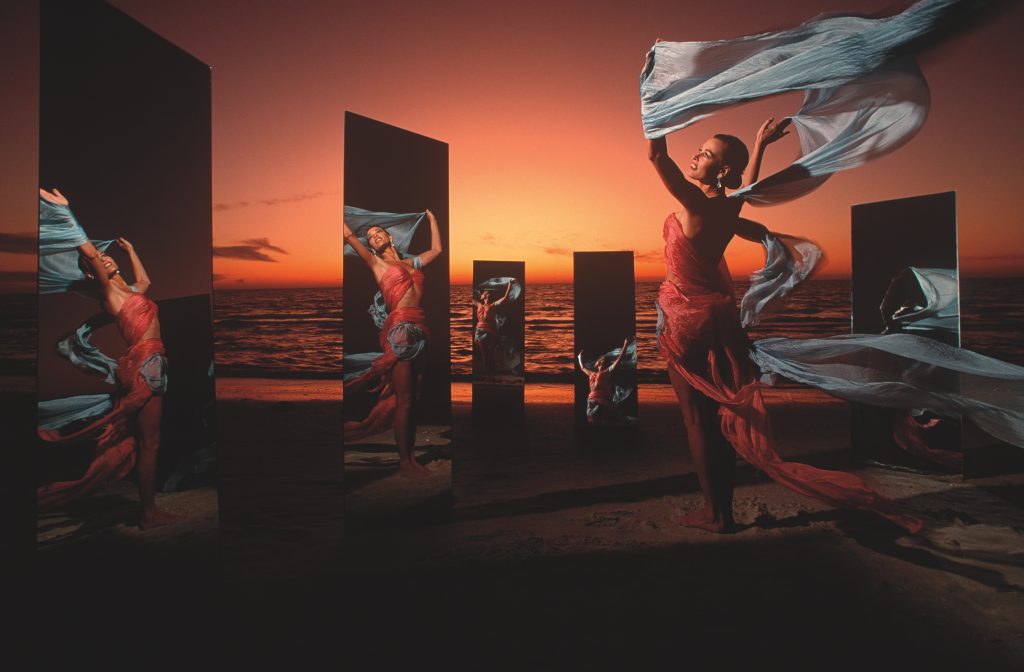
I’ve tried flashes on a beach with a bunch of body builders. Manual settings on all these flashes, which were SB-26 units, which had a built-in optical eye, an important step on this tortuous path to TTL dependability and Speedlight sophistication.
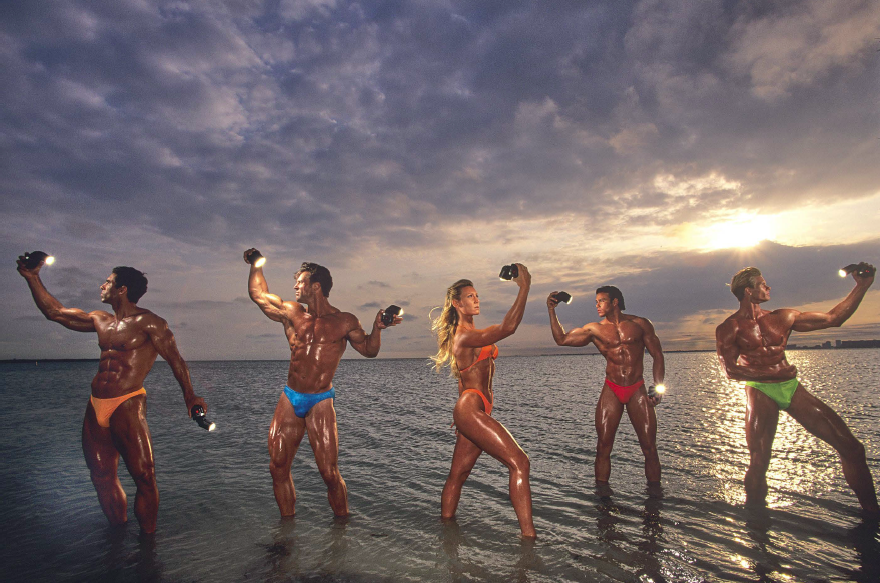
I used these units to create my favorite cover I ever shot for Nat Geo (below, left). SB-26 units, popping through a bed sheet in Mumbai, India. Continued steps to more knowledge. I enlarged my thinking of what might be possible. Shot on Kodachrome 64. No LCD. No confirmation. No do-overs. Trust the machine.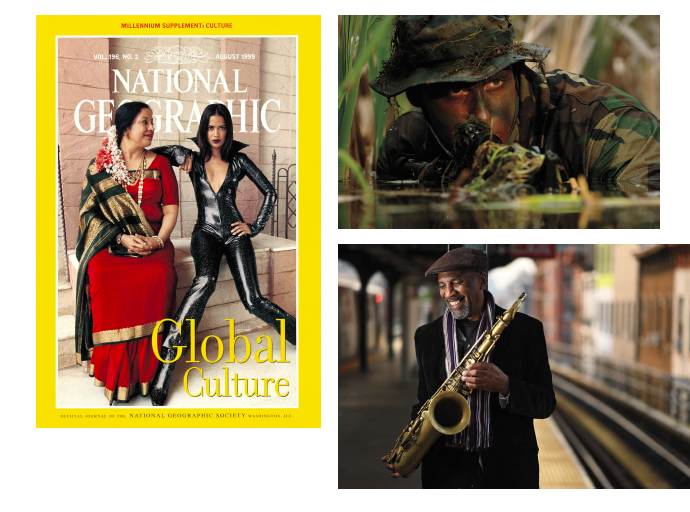 I dragged a line-of-sight Speedlight into a swamp at one point (above, top right). Put it on a C-stand extension arm with a warming gel, got up at 3:00 a.m., donned a heavy wetsuit, and jumped into the mucky end of a lake in Connecticut in the winter! Scott, my assistant at the time, was straight out of Florida, and grew up running a swamp boat, so he was cool about the murky water, holding the light. He was relaxed. As he said to me, “No alligators in Connecticut.” Sigh of relief there.
I dragged a line-of-sight Speedlight into a swamp at one point (above, top right). Put it on a C-stand extension arm with a warming gel, got up at 3:00 a.m., donned a heavy wetsuit, and jumped into the mucky end of a lake in Connecticut in the winter! Scott, my assistant at the time, was straight out of Florida, and grew up running a swamp boat, so he was cool about the murky water, holding the light. He was relaxed. As he said to me, “No alligators in Connecticut.” Sigh of relief there.
The flash was the only thing warm that morning. This was shot on a major job for a huge company. Simulated special forces scenario. It all hung on one battery-operated Speedlight.
But it’s just light. Push it, pull it, prod it. Like the look, or don’t. Keep moving. Keep cooking. Get one flash sorted out. Make it your friend. It’s just one light! Simple. None of the lighting solutions in these pictures so far (i.e., “experiments throughout the years”) derived their look from the use of a light shaper. No umbrellas, no softboxes. Just raw light, blasting away. (Okay, well, in one instance, into a bed sheet.)
So much mystery is gone! Here’s a recent image (above, bottom right), made with new SB-5000 units and a new radio controller. In this instance, finally, I used light shapers, but the simplest of shapers, the kind you can stuff in a camera bag. Two Speedlite Two Plus softboxes, designed by yours truly. My friend Les was down the platform in Brooklyn, and I was shooting an 85mm at f/1.8 with a Z 7II mirrorless camera. Mirrorless tech. Improved metering. Improved flash connectivity. Fast, sharp lens. Beautiful LCD. Instant knowing. Touch-screen adjustments. Infinitely adjustable white balance. Pinpoint, accurate autofocus.
I mean, you take this stuff out on location, with all the attendant bells and whistles, and it’s a bit like Christmas.
Try it. Use a flash. Banish the darkness. As Bane said to the doctor when the plane was falling from the sky, “Now is not the time for fear! That comes later!”
